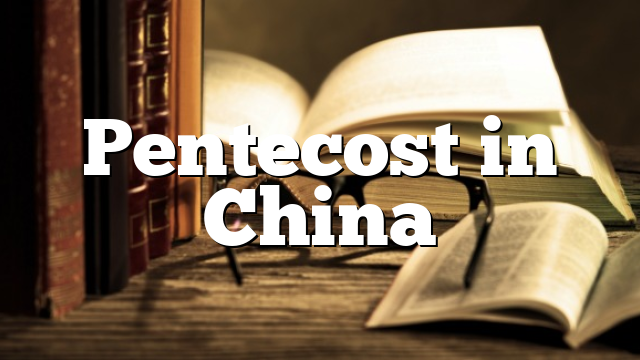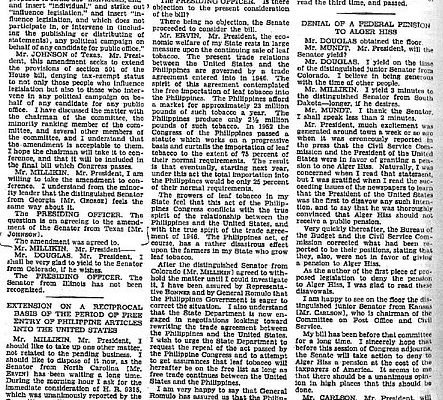Click to join the conversation with over 500,000 Pentecostal believers and scholars
Click to get our FREE MOBILE APP and stay connected
| PentecostalTheology.com



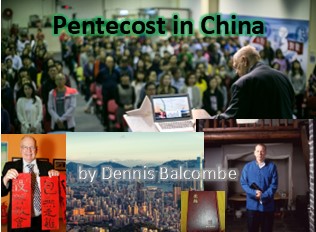
The Holy Spirit has been making Jesus known in China. Veteran missionary Dennis Balcombe shares what he has seen unfolding during his more than fifty years of ministry in China.
Bible teachers believe that many prophecies will have a double fulfillment. The first fulfillment was in the Biblical days and subsequently the last days before the return of Christ.
A good example are the many prophecies relating to the dispersion and restoration of Israel. This was first fulfilled in the Assyrian and Babylonian captivities, and later the return to Jerusalem and rebuilding of the temple under leaders such as Ezra and Nehemiah.
Then in the end times we see this is the destruction of Jerusalem and dispersion of the Jews in AD 70, and the restoration of Israel as a nation in 1948.
Directly relating to this was that of Pentecost which was fulfilled in New Testaments days in the Book of Acts and is being fulfilled in our days, which may be the last of the last days.
Acts 2:1, “When the day of Pentecost had fully come” seems to indicate what happened that day in Jerusalem fulfilled all the types and prophecies relating to Pentecost. Then Peter in his sermon by revelation said, “But this is what was spoken by the Prophet Joel: And it shall come to pass in the last days …” (Acts 2:16).
The whole prophecy of Joel indicates a world-wide outpouring of the Holy Spirit resulting in all that was lost being restored and a great spiritual harvest. It would seem that this prophecy relating to a Pentecostal outpouring was fulfilled in many parts of the world in the beginning of the 20th century.
Pentecostal Christians in many nations will tell you how Pentecost came to their nation in the first few years of the 20th century. Americans talk about the Azusa Street Revival in 1906, people living in the U.K. will tell you about the early Welsh revival and the ministry of Spirit-filled men of God like Alexander Boddy, Smith Wigglesworth around 1907 and the powerful revivals that shook the British Isles around that time.
This was the same time of great revivals in Pyongyang, Korea, Ireland and South Africa, and the Khasi Hills in India. But many have not heard that Pentecost also came to China in the beginning of the 20th century.
A former street evangelist who was a part of my home church in Oakland, California, Richard Simpson, told me the testimony of his grandfather, a missionary to China.
Missionary William Wallace Simpson was sent out by the Christian Missionary Church (but no relation to A.B. Simpson) and began his ministry in Lhasa, Tibet in the late 19th century (1892). After many months of travel by land from Shanghai travelling through vast plains, forging rivers and ascending high mountain ranges he reached the outskirts of Lhasa.
To his knowledge, no Christian missionary had entered the city to bring the message of Christ, though other European explorers and travelers had previously reached the city. One of the head lamas had gotten the word that Simpson and his entourage had entered Lhasa to bring the Christian religion.
Thus, this lama stood outside the city and proclaimed that if this missionary so much as dared to enter the city to preach his foreign religion, Simpson would be struck dead by the Tibetan gods.
After prayer and knowing he was being led by the Spirit, missionary Simpson entered the city and began to prepare for ministry in the city. However, before he could do anything, this lama who was opposed to him, for some strange reason suddenly died.
This was one of the first examples of ‘power evangelism’ in China, a term that later became popular under John Wimber of the Vineyard Movement in the second part of the 20th century.
The superstitious people in Lhasa revered him as some god with great power. Of course, he denied that he was a god, but through this preached Christ to them and reportedly made some converts. Later they gave him gifts of many of their precious temple artifacts (not realizing their archeological value), which he took back to the USA and sold to the Museum of Chicago. Through this he was able to finance his missionary work in China for several decades.
A Pentecostal revival, including glossolalia, broke out in Beijing in 1900.
Right around the turn of the century he was led by the Spirit to go to Beijing (then called Beiping or ‘northern peace’) to pioneer a Chinese church. During prayer many in his congregation began to speak in tongues, something at that time was only known about from reading the Book of Acts. The result was a revival in his church with many supernatural healings including one individual who was raised from the dead right in a meeting. The year was 1900.
A few years later the CMA denomination in America took a stand against speaking in tongues and such Pentecostal gifts. Knowing Simpson’s Church in Beiping was now Pentecostal he was ordered to cease teaching Pentecostal doctrines, tongues, and spiritual gifts, or else they would totally cut off his missionary support.
He wrote back, “I am now the pastor of this church, and they are totally supporting me. I don’t care if you cut off my support, but I will not compromise on my beliefs.”
Significant Pentecostal revivals came to the Scandinavian nations, and many Pentecostal missionaries from Norway, Sweden and Finland travelled to the interior of China bringing the Pentecostal message.
True to their warning they cut him off, but years later after the forming of the Assembly of God, he joined this Pentecostal denomination in 1918, continued to plant churches and preach the Pentecostal message.
He remained in China until 1949 when he returned to the USA. His son, William EkvalI Simpson, also was an Assemblies of God missionary. He died at the hands of bandits on the Tibetan-Chinese border in 1932. This testimony was related to me by missionary Simpson’s grandson Richard in the 1970’s.
After the Pentecostal revivals at Azusa Street and in the U.K., many Pentecostal missionaries came to China and preached the Full Gospel message. Significant Pentecostal revivals came to the Scandinavian nations, and many Pentecostal missionaries from Norway, Sweden and Finland travelled to the interior of China bringing the Pentecostal message.
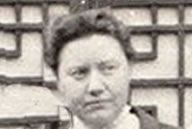
Marie Monson
Image: Wikimedia Commons
One of these Scandinavian missionaries was Marie Monsen (1878-1962). Some considered her the ‘mother of the house church’. But due to her Pentecostal beliefs, she was denounced as a heretic by other evangelical missionaries.
Brother Yun introduced Monsen in his book, The Heavenly Man, as her ministry impacted the churches in Henan where he is from. You can visit her monument today in Bergen, Norway.
Many of these early Pentecostal missionaries were single young women, at great cost and much opposition, spread the Pentecostal message throughout China. Another was Serene Løland, also from Norway, who spent 50 years in China. The last several years of her missionary life was spent in Hong Kong. I was privileged to work with her in Hong Kong in the early 1970s.
Serene was the first Norwegian Methodist missionary to China landing in Fuzhou (then spelled Foo-chow) in 1921. She later worked with the famous Spirit-filled Chinese evangelist, John Sung who is reported to have led over 100,000 to the Lord through his powerful evangelical ministry followed by signs, wonders, and miracles. These converts were not only in China, but many nations throughout SE Asia.
She also spent much time in Shanghai where she helped many leading clergymen to receive the baptism of the Holy Spirit. This was during the great charismatic revival in Shanghai around 1948.
At the Presbyterian Theological Seminary in Shanghai, more than 50 of the theological students including their president, the famous Chia Yu Ming, came to her meetings and he received the baptism of the Spirit. His writings were the most popular theological books in China, read by far more than Watchman Nee, whose books were only read by members of his church, The Little Flock church.
Sister Løland worked closely with the most renowned men of God during that period: John Sung, Watchman Nee, Wang Ming-tao, Andrew Gih and Markus Cheng. She was at one time a member of Watchman Nee’s congregation and she told me she prayed with him, and he received the Baptism of the Spirit. But Watchman Nee never claimed to be charismatic.
After most missionaries were forced out of China, Sister Løland remained two more years and in March 1951 came to Hong Kong. She was greatly used of the Lord to promote the Pentecostal movement throughout Hong Kong, especially among the Pentecostal Holiness Church. She left HK to return home to Norway in 1972. Her powerful testimony is related in her autobiography, God in China (now out of print).
Many in the Charismatic/Pentecostal movement have become aware of missionary Heidi Baker. She and her team have been greatly used of the Lord to plant thousands of churches in Mozambique, other parts of Africa and other nations.
Heidi and her husband Rolland were a part of my church in Hong Kong for many years and even today we can converse in fluent Cantonese. I converse with Rolland in Putonghua (Mandarin), for he comes from a family of missionaries to the Chinese.
Rolland’s grandfather was the famous H.A. Baker who wrote the book Visions Beyond the Veil (published 1920), and several other books. He ministered in Tibet from 1911-1919, in Yunnan China from 1919-1950 when all missionaries were forced to leave China. Later in 1955 he went to Miaoli County, Taiwan until his death in 1971.
With his wife Josephine, H.A. Baker started a mission for street children living in the village areas in Yunnan Province, called Adullam Rescue Mission. The children, 6-18 years old were uneducated and few had any knowledge of the Bible and Christianity.
But H.A. Baker led them to be baptized in the Holy Spirit, and they saw a series of visions of angels, Jesus, heaven, and hell, totally confirming the Bible. This was part of a significant Pentecostal revival in that part of China.
Many of these children grew up serving the Lord, and many were later pastors of both house church and official Three-Self Patriotic churches in Yunnan. This amazing book documenting the working of the Holy Spirit in the lives of these children is available free as a PDF file on the internet.
The great Pentecostal revivals that swept China from the late 1920s until the establishment of the communist PRC in 1949 are mostly unknown.
Also unknown to many are the great Pentecostal revivals that swept China starting in the 1930s right up the establishment of the PRC in 1949. I will briefly mention three: “The Great Shandong Revival”, the “True Jesus Church” and “The Jesus Family.”
My close friend and co-worker, Rev. Moses Yu (1920-2010), born and raised in Shandong, was only 12 when this great revival swept NE China. He could personally recount many events in this revival and he was associated with the great men of God during that period – Rev. John Song, Wang Ming-Tao, Andrew Gih, Chia Yu-ming, Watchman Nee, Allan Yuan and others.
He told me that the indigenous Chinese Pentecostal revivals from the late 1920s through to 1949 were powerful and widespread resulting in hundreds of thousands of conversions. However few if any books giving testimonies to these revivals are available in bookstores.
The reason is most of the publishers of books of Chinese church history are evangelicals, and all their associated denominations theologically hold to the cessation theory. This belief which is adhered to by many even today teaches that all supernatural gifts of the Spirit, speaking in tongues and miraculous healings ended in the 2nd century with the death of the apostles.
Thus Rev. Yu was invited to Hong Kong to conduct a week-long seminar at the Assembly of God Bible Seminary in which he in detail documented the great Pentecostal revivals in indigenous Chinese churches. They can be found today in the Ecclesia Bible Seminary archives.
Space will only allow me to briefly mention a few. Probably the most significant was the Great Shandong Revival which began around 1932 in Shandong Province. The great Korean Pyongyang Revival of 1907 came after years of Western missionaries and Korean pastors associated with the Presbyterian Church seeking the Lord in prayer and fasting.
At a certain time in history, the Holy Spirit moved mightily, and many stood up and openly confessed their sins. Subsequently thousands were baptized in the Holy Spirit with tongues, prophecy, anointed preaching, divine healings, and casting out of demons.
Anyone visiting the house churches and even official churches in Shandong Province today will realize much of the present church leadership are the descendants of the Great Shandong Revival that began in 1932.
This was repeated in Shandong, but it was the missionaries and pastors associated with the Southern Baptist church from the United States, not Presbyterians. It was one of the great revivals recorded in church history and the Pentecostal manifestations were probably much more prevalent than the Pyongyang Revival.
Anyone visiting the house churches and even official churches in Shandong Province today will realize much of the present church leadership are the descendants of this great revival that began in 1932. In fact, this great Pentecostal Revival spread throughout all of NE China.
A Baptist missionary, Mary Crawford published a book, The Shantung Revival in 1933. Again, in as much the manifestations of the Spirit in that revival go against the theological position of the Baptist church, it is not available from the Baptist Press. But the copyright period expired, and the charismatic leader Randy Clark has republished this book which is available today on Amazon.
Directly related to the Shandong Revival, the Jesus Family movement was established in 1921 by Jing Dianying in the rural village of Mazhuang, Taian County of Shandong Province. This was a unique Pentecostal communitarian church.
They lived in Christian communes in which resources were pooled and needs of the poorer in the community were met. In the rural and semi-rural areas, the Jesus Family was formed into small communes of up to a few hundred with the believers working and living together and holding property in common under the direction of the ‘family head.’
There were well over one hundred of these Jesus Family communities by 1949, with a total of several thousand members. All were run entirely by Chinese under the leader Jing Dianying (1890-1957).
The Jesus Family was strongly millenarian, anticipating the imminent return of Christ, and it was very Pentecostal, basing its worship and behavior on the gifts of the Holy Spirit. All the Jesus Family communities were disbanded in 1953, but even today many former adherents or their children are active members and leaders in the Chinese Christian community. In the 1980s, some Jesus Family groups reappeared, but they are technically illegal and subject to persecution by the authorities.
I was privilege to meet many of the leaders of the Jesus Family when China opened in the 1980s and several years ago visited some of the local Shandong house churches whose roots can be traced to the Jesus Family. They would all rehearse testimonies of miracles, healings and gifts of the Spirit that even today are in operation in their local churches.
Another indigenous Pentecostal movement is the True Jesus Church. It was started in 1917 by Paul Wei, Barnabas Zhang and others. It is a powerful Pentecostal Church with many gifts of the Spirit, healings, and miracles. However, they are considered a oneness church because they do not believe in the trinity. They also meet on Saturday as they believe they must keep the Sabbath.
The True Jesus Church is currently one of the largest Christian groups in China and Taiwan, as well as one of the largest independent churches in the world. A few years ago, on a visit to Wuchang, the head leader of the Three-Self church took me to visit one of the True Jesus churches. They had a huge building that could sit several thousand. He told me one-third of all the Christians in the Wuhan area went to churches associated with the True Jesus movement.
He said since they are considered an indigenous Chinese grass-roots movement with no connection with the West, they are not persecuted in the same manner that denominational churches related to the West are persecuted. There are many very large True Jesus congregations in Hong Kong and parts of England.
When I first arrived in Hong Kong in as a missionary called to China in 1969, there was virtually no accurate information about the church in China. The prevalent belief was that Christianity had been basically eliminated from China.
It was common knowledge, though, that all religion had been prohibited during the Cultural Revolution (1967-1976). Even the Three-Self Patriotic Church, which was totally under the control of the Communist Party and preached only liberal theology, was closed. House churches were prohibited, all clergy were sent to labor reform camp or prison, seminaries and Bible Schools were closed, and all Bibles and religious books were destroyed by the Red Guards.
It was assumed by many that the whole nation had become atheistic. As China began to open in 1978, one major ministry printed a tract which simply described the beautiful mountain scenery in Guilin (such as you see depicted in Chinese landscape paintings), and ended with this question, “Is it possible all this somehow occurs through natural processes, or might there perhaps be a Creator?”
One would ask why the Gospel tracts would not be more specific in presenting Christ and the Gospel message. The reason is there was a fear that any religious literature would be confiscated and those distributing it would be arrested. It was thought except for a few older people in the villages, the whole nation was now atheistic.
Had Chairman Mao eradicated Christianity from China?
Most liberal churchmen stated, “What Christianity could not do, Chairman Mao did. Chairman Mao made a ‘new man’ out of the Chinese race.” They claimed crime, prostitution, taking of illegal drugs, gambling, and other vices had been eliminated.
Liberal churchmen stated, “While the people were relatively poor compared to most in capitalist nations, what they had they shared one with another, the government provided basic educational and medical services, everyone loved greatly Mao and the Communist Party, and most were very happy.”
It was then often stated, “There is no need for Christianity, a Western religion that puts guilt on people and allowed imperialism to take root in China.”
However, within weeks of my first trip to Guangzhou in the spring of 1978, I found all that was totally false. During the past several decades we have been learning about the terrible atrocities, massacres, famines, political infighting, and horrendous persecution of religious believers.
No one knows how many Christians were martyred during the Cultural Revolution.
Even after more than sixty years, we are still learning about the horrors of the Great Leap Forward (1958-1962) in which an estimated 32-45 million lost their lives through famine, about 10% of them being victims of the radical leftists. Victims of persecution during the Cultural Revolution, those who were ‘struggled against,’ persecuted, and tortured number in the millions including hundreds of thousands of Christians. Nobody is sure of total deaths during the Cultural Revolution, but it is possibly several million.
Prostitution then and today was rampant, but prostitutes then sold their bodies to get ration coupons, which were needed to purchase food. We saw this everywhere after China opened in 1978, as even then food could only be purchased with both money and ration coupons. As we begin to travel throughout China, we saw not only prostitutes, but beggars everywhere. Poverty was widespread and in visits to hospitals we saw dirty and rundown buildings with almost none of the equipment or medication that a hospital would need.
Chairman Mao had not made a New Man out of the Chinese people. But the persecuted church had grown by multiple millions.
The idea promoted by liberal clergymen in the West that Mao had made a “new man” was not true, but what was true is that the small Protestant house church of perhaps of not much more than one million believers at “liberation” in 1949, had grown by multiple millions.
I was quickly made aware of one group of believers in a certain district in Guangxi Province of 40,000 believers meeting in multiple house churches but was told they only had one full complete Bible for that many believers.
Due to that report in the first of 1979, we began our Bible ministry to China (called Donkey’s for Jesus) and during the 36 years to 2015 (when Xi Jinping began to take tight control of the nation), countless millions of Bibles were delivered to China from Hong Kong. Most were provided free to house church leaders, and thus during those years I was privileged to travel this vast nation.
From 1979 until 2015, millions of Bibles were delivered throughout China from Hong Kong.
I have during the past few decades met with hundreds of house church leaders and even many official church pastors, and have ministered in both churches on multiple occasions. This is what I learned: Through the work of the Holy Spirit in the lives of all Christians, in which the Full Gospel was preached with healings, deliverances and signs following, the Protestant church of a million or less grew to a church of conservatively 70-100 million believers.
Due to the strict control of people’s movements, including that of foreign visitors, it is impossible for anyone to conduct an accurate religious survey. But these estimates are based on the percentage of known Christians in different districts and an analysis of general religious beliefs in the different provinces.
“Through the work of the Holy Spirit in the lives of all Christians, in which the Full Gospel was preached with healings, deliverances and signs following, the Protestant church of a million or less grew to a church of conservatively 70-100 million believers.”—Dennis Balcombe
Many have stated they believe that at least 80% are either Pentecostal or Charismatic Christians. While this is hard to verify, what is true is the fact that most people converted to Christ due to miraculous healings, deliverance from demonic powers, and other miracles that proved the truth of the Gospel.
My story: From 1979-1997 I made multiple trips all over China, weekly taught English in Guangzhou leading a few hundred students to Christ and baptizing them in the Guangzhou reservoir, helped to coordinate the Bible ministry in which weekly thousands of Bibles entered China, and travelled all over the nation where I met the Christian leaders in hotel rooms or public parks in the major cities.
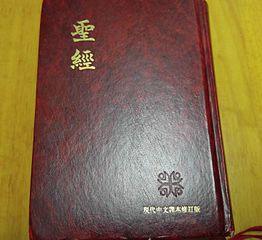
Today’s Chinese Version Bible, first published in 1979.
Image: Wikimedia Commons
I had a great desire to visit the rural home churches, especially in Henan (where Hudson Taylor previously worked), but was told it was far too dangerous for a foreigner to visit these house churches. But knowing that our church was a Spirit-filled Pentecostal church, and almost 100% of the Bible couriers and those supporting the ministry were Pentecostals, they desired for me to visit their home church co-workers’ meetings and teach on this subject.
Thus, in early 1988, they arranged for me to go into the rural areas of Henan, Anhui, and Zhejiang provinces to teach in co-workers’ meetings. The co-workers would number from 80-800 or more. Meetings would last 3-5 days in one village and then we would go to another village to share.
Usually, I would teach and preach for up to 9 hours a day, but during that time in every session we would pray for them to be baptized in the Holy Spirit. This continued until 1997 when I lost my visa, but when my visa was restored in 2003, I continued this ministry until 2015 when I again lost my visa.
Before we visited China and taught the Pentecostal message, they would experience miracles of healing and supernatural deliverances. But this was due to the prayers of the Christians. Even decades before I entered the rural areas to teach the Pentecostal message, the churches had a habit of gathering early in the morning for prayer, often lasting up to 2 hours.
Miracles, signs, wonders, and divine healings were seen everywhere we went.
As people were baptized in the Holy Spirit, they also received gifts of the Holy Spirit: Gifts of healing, words of knowledge, miracles, etc. More than that they received great boldness to openly preach the Gospel. Thus, healings and miracles that followed the proclamation of the Gospel led to conversions of thousands of people.
Space would not allow me to share even a small percentage of what I saw. Just to state that we saw thousands of co-workers filled with the Holy Spirit with speaking in tongues, and a massive outpouring of the gifts of the Holy Spirit. Miracles, signs, wonders, and divine healings were seen everywhere we went.
Many told me the main reason people became Christians was due to the testimony of divine healing, deliverance from demonic powers and other such miracles. While the Chinese church is not perfect, mistakes have been made, some false doctrine and teaching emerged during those years, nobody can deny the fact that the Chinese church is like the Church in the Book of Acts. The Gospel is being widely preached with signs following, but as in the 1st century persecution is prevalent.
The Chinese church is like the Church in the Book of Acts. The Gospel is being widely preached with signs following, but as in the 1st century persecution is prevalent.
The moderate President of the People’s Republic of China from 2003 to 2013 was Hu Jintao. He promoted the ‘harmonious society’ policy. During those years we often visited the official Three-Self Patriotic Churches and with the approval of the authorities ministered in these churches in many cities. Many thus opened to the work of the Holy Spirit with Biblical worship services, praying for the sick, and operation of the gift of the Holy Spirit. During those years official churches would unite with house churches to preach the Gospel in their community.
The last several years there have been a lot of restrictions on Christian ministry in general and many overseas missionaries have been forced to leave China. The government is restricting the evangelism of children and the youth, and Bibles can only be purchased in official church bookstores. Atheistic Marxist education is the norm for all Chinese young people. It would seem the present leadership of China is reversing the ‘open door policy’ of Deng Xiaoping which began in the 1980s.
But we thank the Lord during the few short years that China was opened, thousands of Spirit-filled Christians from overseas entered China to provide Bibles, teaching materials and prayed with countless tens of thousands of Chinese Christians to be baptized in the Holy Spirit.
Thus, the Chinese church has a very good solid foundation based on the Word of God in which the Holy Spirit is honored. I believe despite temporary setbacks, the doors to China are still open in that the Chinese people are very open to Christ and the Holy Spirit. I believe before the return of Christ, perhaps in our generation, this nation of 1.4 billion of Han Chinese and other ethnic groups will be reached with the Full Gospel.
Pastor Dennis Balcombe
Hong Kong

